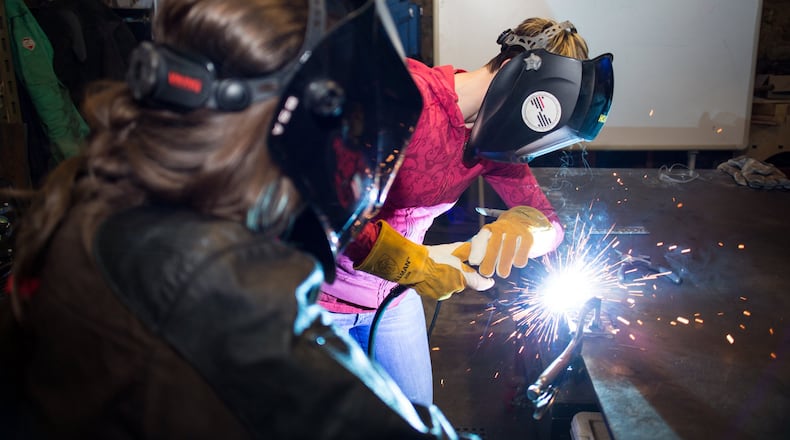As a high school student in Texas, Bria Sativa Aguayo walked past the all-male welding class on the way to her cosmetology class. “I never looked in. I wasn’t even curious,” she says. “It didn’t seem something that I, as a girl, would ever do.”
Twenty-five years later, Aguayo, 43, is now teaching welding and pushing to get more girls interested in the high-paying field, which is confronting a scarcity of workers. One reason: High school girls are still walking by welding on their way to classes in cosmetology, food service and child care.
Women represent 98 percent of students in cosmetology, 87 percent in child care, and 86 percent in health aide classrooms. "There are only 5 percent women in welding but there is a push to increase that number. In Georgia there are financial aid resources like the Hope Career and Zell Miller grants that pay for schooling and make it a very accessible career choice," says Aguayo, founder of the Atlanta-based nonprofit Becoming a Welder Inc. and an executive board member of the Atlanta chapter of the American Welding Society.
The average welder is 55, she says. For every five who retire, only two-and-a-half new welders enter the field. “By 2024 there will be 400,000 empty welding jobs, from apprentices to engineers,” Aguayo says. “The pay ranges from $30,000 to $150,000 or more, depending on the type of welding, and there are a plethora of options for those in the welding field, from industrial sales, to instructors, to those building sets for movies and TV.”
Georgia is among the states touting vo-tech training and industry-awarded credentials as an alternative to a four-year college degree. Nationally, women are not benefiting from career-tech opportunities as much as men, largely because of what they choose to study. At training centers, young men weld joints and repair car engines, while young women wield thermometers and repair split ends.
A 2016 Cornell study on high school training for local blue-collar jobs concluded: Those women who do obtain blue-collar jobs find themselves still on the outside looking in at high-paying blue-collar positions. Among high school graduates ages 25-28 in blue-collar jobs, the hourly gender wage gap was 22 percent, with women making 78 cents for every dollar men make.
How do we get girls interested in fields that pay more? (A tougher question for another day: How do we raise the pay levels in careers dominated by women?)
Aguayo believes we have to show girls early on — starting in the early grades — that welding is something women can do and do well.
“I am trying to rebrand welding so women understand it is something they can handle physically. People like gender roles and to classify jobs into men’s and women’s because it is easy. There are things that I find difficult but there are tools to supplement strength if I need them. I am five-foot-one and I’ve never found lifting steel to be a problem,” she says. “In fact, a couple of men working on a project asked me yesterday to help them lift the pieces into their truck. They had both been in my welding class in the past. I’ve visited Caterpillar and other manufacturers, and lifting was mostly done by machines.”
Women excel at the fine motor skills and attention to detail required in welding, says Aguayo, adding, “And companies like to hire women because they find women are more likely to practice safety and be reliable.”
What girls might be candidates for welding?
“Anyone who likes to work with their hands and wants to do something that’s not expected,” says Aguayo. “I won’t pretend there aren’t challenges because of the disparity in men and women, but overall the industry is seeing the benefit of having more women in active welding roles and doing a lot to recruit women. I’ve been approached by welding schools and organizations to get help with their efforts. I know quite a few women in the area that are either welding or in school for welding and are very excited about what they are doing and like doing something that challenges gender roles.”
Aguayo recently helped eight Boy Scouts earn a welding badge. “I think it was great that the first welder they saw was a woman,” she says. “It changes the perception.”
About the Author


